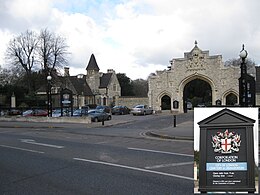City of London Cemetery and Crematorium

The Main gate and sign
|
|
| Details | |
|---|---|
| Established | 1856 |
| Location | London Borough of Newham, London |
| Country | England |
| Coordinates | 51°33′28″N 0°02′40″E / 51.55782°N 0.04432°E |
| Type | Public |
| Size | 200 acres (81 ha) |
| No. of graves | 150,000+ |
| No. of interments | approaching 1 million |
| Website | Official website |
The City of London Cemetery and Crematorium is a cemetery and crematorium in the north east of London. It is the largest such municipal facility in the UK and probably in Europe.
It is owned and operated by the City of London Corporation. It is designated Grade I on the Historic England National Register of Historic Parks and Gardens. Anyone may be interred at the City of London Cemetery irrespective of city connections or religious beliefs. At the City of London Cemetery and Crematorium, they reuse old graves which have not been used for more than 75 years, and which are known to have depth for at least two more burials. English Heritage has listed many burial grounds and says it has no objection to the reuse of graves in principle, as long as heritage is protected.
The cemetery is on the north-east side of Aldersbrook Road, in Manor Park, in the London Borough of Newham, near Epping Forest. It has two entrances: the Main Gate, close to the junction of Aldersbrook Road and Forest Drive; and the South Gate, a small gate at the junction of Aldersbrook Road and Rabbits Road.
In 1849 William J. Haywood, Chief Engineer of the City of London Commission of Sewers, reported on the condition of the city's churchyards and their health risks. The Commissioners were responsible for public hygiene and sanitation and were in effect also the burial board for the City of London, due to an Act of Parliament in 1852. The commissioners directed that a cemetery be built for the city's 106 parishes, to replace intramural interment (burial within the confines of a parish). The task was taken up by William Haywood and Dr John Simon.
In 1853 this led to the purchase of land owned by the 2nd Duke of Wellington, forming most of the Manor of Aldersbrook. The 200 acres (0.81 km2) of land suited the construction of the cemetery because it was accessible (only 7 miles (11 km) to the centre of the City of London), had attractive planting and porous, gravelly, well drained soil. This former farm land was sold to the Corporation for £30,721 and the cemetery was founded in 1854. It was laid out in 1855 by William Haywood, who designated 89 acres (360,000 m2) for burial but also reserved land for plots sold in perpetuity, buildings, landscaping and roads. He was helped by landscape gardener Robert Davidson. In selecting planting, Haywood and Simon were guided by John Claudius Loudon's On the Laying Out, Planting, and Managing of Cemeteries (1843). The total cost is estimated at over £45,000, which is approximately £26,000 more than originally planned.
...
Wikipedia
